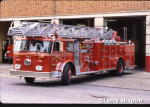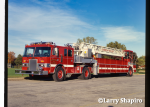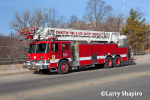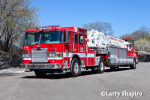This from Phil Stenholm:
The Evanston Fire Department has been running aerial-ladder trailers with tillers (first HDA & then later TDA) since 1907.
Evanston’s first H&L (and it was also one of Evanston’s first two fire apparatus) was a hand-drawn rig purchased from the Babcock Company of Chicago in 1872. It was located in the original EFD station on the first floor of the Village Hall at Church & Orrington 1873-83. It was not an aerial ladder truck, but it was equipped with ladders, axes, pike poles, rope, buckets, and salvage covers. It was only in front-line service until 1883.
The Evanston F. D. was relocated to an old frame paint shop (renovated for use as a firehouse with stable facilities) located on the west-side of Sherman Avenue at the northwest corner of the north alley of Davis Street in 1883 and the EFD became fully horse-drawn at that time, and then Fire Station #1 was relocated again in 1893 to the new City Hall at the northwest corner of Sherman & Davis, and then (again) to the new Police / Fire Public Safety facility at the northwest corner of Grove & Sherman in 1897.
It didn’t have an aerial ladder or a tiller, but Evanston’s first horse-drawn H&L (with a two-horse hitch) was purchased in 1885 (it cost $800) from the Davenport Fire Apparatus Co. of Davenport, IA. It ran as Truck No. 1 at Fire Station #1 1885-1907 and then it was fitted with a 850-ft capacity hose-box and became a “combination truck” (hose & H&L) and was relocated to Fire Station #3 (located at 2504 Railroad Avenue — later known as Green Bay Road) in July 1907 (where it replaced the hose-wagon that had been in service at that station since it opened in January 1901), and it ran as “Truck No. 3” 1907-1917. (It was the only rig at Station #3 1907-1911, then it was the second section of Engine Co. 3 beginning in January 1912 when the 1895 Ahrens 600-GPM steamer was transferred from Station #2 to Station #3).
Evanston purchased a horse-drawn “combination truck” (a combination H&L and chemical engine) from Seagrave in 1902. There was not sufficient manpower to place it into service right away and it did not fit into Station #2 (the former South Evanston Village Hall / Police Station / Fire Station located at 750 Chicago Avenue that was functioning in 1902 as the combined Fire Station #2 and the Evanston Police Department’s “South Precinct” station), so the EFD had to wait for additional manpower to be authorized by the City Council and for the new Station #2 to be completed (constructed on the site of the old South Evanston Village Hall) in 1903.
Like the Davenport truck at Station #3, the Seagrave combination truck at Station #2 was fitted with an 850-ft capacity hose box in July 1907 as the hose-wagon at Station #2 was taken out of service. (The horse-drawn hose wagons at Station #2 and Station #3 were taken out of service in July 1907 to provide the four horses required to pull the new HDA at Station #1).
Evanston acquired its first aerial-ladder truck (with a tiller) from American LaFrance in July 1907. It was an 85-ft HDA (with a four horse-hitch) that cost $6,700 (which was a lot of money in 1907). It ran as Truck No. 1 for about nine years, before it was demolished in a collision with an Evanston Railway Company streetcar at Grove & Sherman in September 1916 while responding to a still alarm on Hinman Avenue. Two firefighters riding on-board were seriously injured in the wreck.
There was already a master plan in place to fully motorize the EFD when Truck 1 was totaled, with one element of the plan to replace the four horses pulling the HDA with a truck tractor. But obviously this never happened.
So the EFD leased a 25-year old HDA from American LaFrance for almost a year (January -November 1917). It was an ex-Chattanooga F. D. 1891 LaFrance/Hayes 55-ft HDA that had been traded-in to American LaFrance when Chattanooga fully motorized its fire department with American LaFrance automobile rigs in 1916.
A $30,000 bond issue to fully motorize the Evanston F. D. was passed by Evanston voters in April 1917, and Seagrave got the contract to supply all of the rigs:
1. A 750-GPM engine equipped with a 50-gallon chemical tank that went into service as Engine No. 1, replacing the 1911 Robinson “Jumbo” 750-GPM pumper (the Jumbo being Evanston’s first automobile pumper, which was retained as the EFD’s lone “spare” automobile rig 1918-29).
2 & 3. Two identical 300-GPM chemical & hose “booster” pumpers equipped with 50-gallon chemical tanks (one rig known as “Truck 2” and then later as “Hose 2” went into service as the second section of Engine Co. 2 replacing the horse-drawn 1902 Seagrave combination truck, and the other went into service as Engine No. 3 replacing the horse-drawn 1895 Ahrens steamer and the 1885 Davenport H&L at Station #3)
4. A Model “K” one-axle tractor to pull the formerly horse-drawn 1906 American LaFrance 700-GPM steamer (which was now a so-called “tractorized-steamer”) at Station #2;
5 A Model “E” city service truck that went into service as the new Truck No. 1, replacing the ex-Chattanooga F. D. HDA. The city service truck was equipped with ladders of various types and lengths but no aerial ladder, and the tallest ladder was a ground-based 55-ft extension ladder that required four men to raise with tormentor poles.
EFD Chief Albert Hofstetter said at the time of the bond issue that Evanston did not need an aerial ladder truck because all of Evanston’s tallest buildings had fire escapes, but when the National Board of Fire Underwriters (NBFU) inspected the EFD in 1923, it strongly recommended that Evanston add an TDA ASAP. Five multi-story hotels and many of the two and three-story apartment buildings that dot Evanston’s landscape were built in the years 1917-23.
So to keep Evanston’s NBFU rating at “3,” the Evanston City Council quickly appropriated $16,500 to purchase an 85-ft TDA. Seagrave won the bid and the new truck was placed into service as the new Truck No. 1 in September 1924. The former Truck 1 (the 1917 Seagrave city service truck) became Truck No. 2 (as Truck Co. 2 was organized on September 1st). Both Truck Co. 1 and Truck Co. 2 ran out of Station #1 for 30 years. Truck Co. 1’s first-due district was the area east of Asbury Avenue where most all of the city’s tall buildings were located, Truck Co. 2’s first-due district was the area west of Asbury Avenue which consisted of mainly single-family residences and a few factories along the C&NW RR Mayfair Division tracks. Both trucks responded to alarms at schools during school hours, hospitals, and retirement & nursing homes.
Evanston ran with just the one aerial ladder truck (Truck 1) for 13 years. Truck 2 was replaced with a Seagrave “Service” 65-ft aerial ladder truck with a 50-gallon booster tank in 1937. It was called a “Service” aerial because the aerial ladder was mounted on the old Seagrave city service chassis. The 1917 Seagrave city service truck (formerly Truck 2) then became “Truck 3” (the EFD’s reserve truck). This rig was also assigned to the volunteer Evanston Auxiliary Fire Service during WWII, along with one of the old 300-GPM booster pumpers
So Evanston had two aerial ladder trucks, but only one TDA as of December 1937.
A new combined Police Station HQ & six-bay Fire Station #1 was constructed at the northwest corner of Lake & Elmwood in 1949, and the City Council appropriated funds to purchase a new 85-foot TDA to replace Truck 1 (the 1924 Seagrave TDA) in 1950. Pirsch won the bid (the first time Evanston purchased a rig not built by Seagrave since 1911) with ETA expected in 3rd quarter 1951. However, Evanston voters approved a $135,000 bond issue in April 1951 that provided funds to purchase three new pumpers (one of which was a combination pumper-rescue squad) and two new TDA (this included the new truck that was already on order, so the 1950 separate appropriation was canceled).
Pirsch won the bid to supply all five of the rigs (not just the new Truck 1) from the bond issue. Pirsch out-bid American LaFrance and Seagrave for the TDA, and Mack for the pumpers.
Besides acquiring new apparatus, some of the funds from the bond issue were used to purchase new hose and other needed equipment including modern SCBA for the two trucks, and two-way radios. With radios being installed in 1952, the EFD changed the numbering of its companies to the “20-series” so Truck Co. 1 became “Truck Co. 21,” Truck Co. 2 became “Truck Co. 22,” etc, to avoid confusion with other fire departments that were already operating on the same radio frequency.
The new Truck 1 arrived a year before the others (it became “Truck 21” when radios were installed in 1952), and the other four rigs (Engine 21, Engine 25, Squad 21, and Truck 22) arrived in September 1952. All five of the new Pirsch rigs were assigned to Fire Station #1, so Evanston residents could drive past or stop-by and view the EFD’s modern fleet of fire apparatus all in one place.
The tractor and the trailer of the old Truck 1 (the 1924 Seagrave TDA) were separated and the trailer & wooden aerial ladder were junked, but the tractor was retained and converted to a Chicago F. D.- style “high-pressure wagon” (known as “Squad 22”) with a hosebed from one of the old 1917 Seagrave pumpers that was junked in 1952 placed onto the Seagrave tractor. A high-pressure nozzle was fitted on top and the rig was also equipped with large-diameter “fireboat” hose and specialized portable master-stream and high-pressure nozzles.
The old Truck 2 (1937 Seagrave 65-ft service aerial truck) became the EFD’s reserve truck (Truck 23) at Fire Station #3 on Green Bay Road when the new Pirsch TDA was placed into service as the new Truck 22 at Station #1 in 1952. However, the Seagrave truck was placed back into front-line service when a third truck company (Truck Co. 23) was organized at the new Fire Station #3 at 1105 Central Street when it opened in September 1955.
Meanwhile, Truck Co. 22 was relocated to the new Fire Station #2 (and EFD HQ) at 702 Madison Street in March 1955. There wasn’t room for an aerial ladder truck at the old Station #2, which is why both trucks ran out of Station #1 1924-55.
In 1962, EFD Chief James Geishecker requested the City Council appropriate funds for a new 100-ft TDA for Truck Co. 21 at Station #1, with the existing Truck 21 (the 1951 Pirsch 85-ft TDA) to be moved to Station #3 and become Truck 23, replacing the 25-year old 1937 Seagrave 65-ft truck, which would go into reserve. The EFD had no reserve truck after Truck Co. 23 was organized in 1955.
The city Council refused to appropriate funds for a new 100-ft TDA in 1962 (although they did five years later), and so Chief Geishecker took Truck Co. 23 and its 25-year old rig out of service and transferred Truck 23’s manpower to Squad 21 at Station #1, as Squad 21 became a fully-manned company. Squad 21 previously had been the “inhalator squad” and rescue truck, responding to inhalator calls city-wide, specialized rescue calls, and working fires, and manned by only two firefighters when needed.

Larry Shapiro photo
Evanston finally purchased (at a cost of $60,000) a new 100-ft TDA in 1967 (it arrived in December 1968). A Pirsch “Senior” TDA, it went into service as the new Truck 21 in January 1969.
The former Truck 21 (1951 Pirsch 85-ft TDA) was then relocated temporarily to Station #2 where it ran for several months in 1969 as Truck 22 while Truck 22 (the 1952 Pirsch 85-ft TDA) was “modernized” at the Pirsch factory in Kenosha (at a cost of $20,000). The tractor was refurbished (most obvious differences were new fenders and dual headlights and a new Mars rotating beacon light), and the 85-ft aerial ladder was re-mounted on a new trailer. The 1951 Pirsch TDA became the EFD’s reserve truck (Truck 23) and the 1937 Seagrave 65-ft service aerial ladder truck was junked when Truck 22 came back from the Pirsch factory later that year.
The ISO did an inspection of the Evanston Fire Department in 1977 and (among other things) concluded that the EFD needed more front-line GPM pumping capability. Squad 21’s 1965 International pumper-squad — which functioned as a second engine at Station #1 — was replaced by a Chevrolet Versatile-Van in 1977. This resulted in Evanston (hurriedly) purchasing a new Pirsch 1250-GPM pumper (it was already being built at the Pirsch factory as an “off-the-shelf” spec rig when Evanston bought it) to replace an older 1970 Pirsch 1000-GPM pumper at Station #2, and a Seagrave 1250-GPM / 100-ft RMA quint which was placed into service at Station #1 as the new Truck 21.

Larry Shapiro photo
These two acquisitions (the Pirsch pumper and the Seagrave quint) helped the EFD get its tentative ISO Class 4 rating moved back up to Class 3 as it had been for more than 50 years, but the long-term plan was actually to relocate Truck Co. 21 and its Seagrave quint to Station #3 where it would become Truck Co. 23, take Engine Co. 23 out of service, and use the manpower from the disbanded Engine Co. 23 (three firefighters per shift) to place a fourth firefighter on the quint and place a third ambulance in service at Station #3.
Unfortunately, it turned out the Seagrave truck had some design flaws, most notably that if the 300-gallon water tank was filled with water (which it would need to be if ran as a quint at Station #3), the single rear axle would break (which it did). What Evanston did not know when they bought it was that the rig would needed two rear axles in order to provide enough support for the added weight from the water in the tank.
Meanwhile, the 1968 Pirsch 100-ft TDA was relocated to Fire Station #2 in 1980 (and became the new Truck 22) when the Seagrave quint was placed into service at Station #1 (the ’68 Pirsch tractor also got a diesel engine), the former Truck 22 (the 1952 Pirsch 85-ft TDA that was refurbished in 1969) was moved to Station #3 (where it became the reserve truck (Truck 23), and the 1951 Pirsch 85-ft TDA was junked. Truck 23’s 1952 Pirsch tractor (the one refurbished in 1969) was replaced in 1982 by a 1968 GMC / Pirsch tractor that had formerly been in service with the Aurora F. D. in Colorado.

Larry Shapiro photo
The EFD purchased two new TDAs from Pierce equipped with 105-ft Smeal aerial ladders in 1990 and 1991. The first one went into service as Truck 22 at Station #2 in 1990, and the second one became the reborn Truck Co. 23 at Station #3 in 1991, as Truck Co. 21 became Truck Co. 23 and was relocated from Station #1 to Station #3.

Larry Shapiro photo
All of the EFD’s older trucks were junked by the mid-1990’s, and so the EFD went in search of a used truck it could acquire quickly. The initial plan was to purchase a 25-year old RMA from Highland Park F. D. (ex-HPFD Truck 31), but it was found to be mechanically unsound and not even useful as a reserve truck.

Larry Shapiro photo
Evanston ended up purchasing a rebuilt 1990 Pierce / Smeal RMA in 1998 for use as a reserve truck. This rig was formerly owned by the San Antonio F. D. in Texas before the aerial ladder was totaled in a load-test mishap that required the aerial ladder to be replaced.

Larry Shapiro photo
A new Pierce Arrow XT 105-ft TDA (the new Truck 22) was acquired in 2011, and another new Pierce Arrow XT 105-ft TDA (the new Truck 23) was added in 2015.
The price of a new TDA has gone up, however, since Evanston’s first HDA was purchased in 1907 for the then unbelievable sum of $6,700. They now cost a cool million bucks.



















































Pingback: Evanston Fire Department history (more) « chicagoareafire.com
#1 by Mike L on December 8, 2020 - 3:44 PM
Winnetka also had a snorkel. As for Evanston getting one, it was never seriously considered due to so many trees and other issues. That was the main reason I was given by my dad and others who were on in the 70s and into the 80s. Prior to Dutch Elm and then Emerald Ash borer, most all of the streets were dense with trees which hindered the ability for a snorkel to set up. Phil may have heard another reason but that was what I was always told.
#2 by Phil Stenholm on December 8, 2020 - 1:52 PM
BILL: Winnetka also had a snorkel in the 1980’s when I was dispatching with Evanston. The Winnetka snorkel was on the box alarm assignment (along with a Wilmette engine and a Skokie truck) on the Evanston MABAS box card at that time.
But the Evanston F. D. never seriously considered purchasing a snorkel, They had difficulty just getting new engines and trucks. It was like pulling teeth to get the City Council to appropriate funds for the 100-ft TDA (Truck 21) and the 1250 GPM pumper (Engine 21) in 1967, even with two high rise office buildings (State Bank Plaza and One American Plaza) under construction, and there was just no way the City Council would have approved money to buy a snorkel without the EFD demonstrating a compelling need for one.
The Evanston City Council in the 1960’s was always looking for ways to cut corners with the Fire Dept.
For instance, a Pirsch 1000 GPM pumper (which went into service as the new Engine 22 in 1970) was donated by Northwestern University. It was almost like Evanston was some backwater town or third-world country that couldn’t afford to buy new fire trucks.
The City Council was more interested in refurbishing older rigs and buying commercial chassis in the 1960’s.
The body on the original Squad 21 (the 1952 Pirsch pumper-squad) was removed and replaced with a standard pumper body in 1966 (and it ran as Engine 22 1966-70 and then as Engine 25 1970-76).
The City Council also added an additional International-Harvester commercial truck chassis to it’s garbage truck order in 1965, and the extra IH truck chassis was sent to General Body Company in Chicago and a GBC-designed custom-built pumper-squad body was installed along with a turret nozzle, high-powered quartz lights, a front bumper mounted heavy-duty winch, and a separated hose bed for two leads of 1-1/2 inch pre-connect lines (somewhat like the CFD’s fog pressure rigs of the 1960’s), and it ran as Squad 21 1966-77.
In fact you couldn’t miss it back in the day. It was the SS-1 of the EFD. Squad 21 was everywhere. It went to all fire calls city-wide, and it was first due in Station #1’s district for inhalator calls, car fires, trash fires, and smoke investigations, it carried the specialized extrication equipment of the day, and it’s crew also manned the DUKW (F-7) for boating-related incidents on Lake Michigan (all of which allowed Engine Co. 21 to remain in service for structure fires).
The total cost for the project (converting the original Squad 21 to a standard triple-combination pumper and building a new custom-designed Squad 21 using a commercial truck chassis) was $13,500, The City Council sub-committee reported at the time that the Skokie F. D,. bought a factory-built pumper-squad from Pirsch that same year and it cost Skokie $25,000. That was a big deal to the Evanston City Council. They were really proud of that.
And as I mentioned, Truck 22 (1952 Pirsch TDA) was “modernized” (refurbished) by Pirsch in 1969 (at a cost of $20,000) so that it could remain in front-line service for at least another ten years and so the city wouldn’t have to buy a new truck anytime soon (a new TDA would have cost about $60,000 in 1969), at least not until the 1977 ISO report that downgraded Evanston’s fire insurance rating from a “3” to a “4” got their attention.
#3 by Bill Post on December 8, 2020 - 10:22 AM
Phil that was a great history of Evanston’s truck companies as usual.
In the 1960’s and 70’s, did Evanston ever consider purchasing a Snorkel when it was a popular piece of apparatus?
During the 1960s many fire departments were purchasing a Snorkel and trying it out until tower ladders became popular and took over the elevating platform market. Several North Shore departments which are now part of MABAS Division 3 had Snorkels. Niles purchased one in the early 1960s when they opened the new Station 2 at Dempster and Greenwood. When Skokie opened their new Station 1 in 1969 (currently Station 16) Truck 3 was a 65-foot Pirsch Snorkel. Wilmette had a Snorkel on a Seagrave chassis with a Cincinnati cab.
Back in the 60’s and 70’s when Evanston Station 1 at 909 Lake Street was in service, they had plenty of room for a Snorkel. They could have outfitted a Snorkel as a truck company like Niles and Skokie did so it could have been more cost effective. Perhaps they tried out a Snorkel but decided not to purchase one?
#4 by Mike L on December 8, 2020 - 8:54 AM
Truth to that, John! The Pirsch rigs were great. Even the 79 Cincinnati Cab stock model. It was the last Pirsch bought by the city and was in service as Eng 22 from 79 until 82 when the Spartan/Welch was bought. It then moved to Eng 21 until replaced with a Pierce engine in 1989 or 90.
#5 by John on December 7, 2020 - 8:42 PM
Great post,although I hated to hear of all those Pirsches being junked.